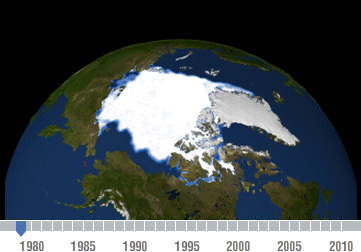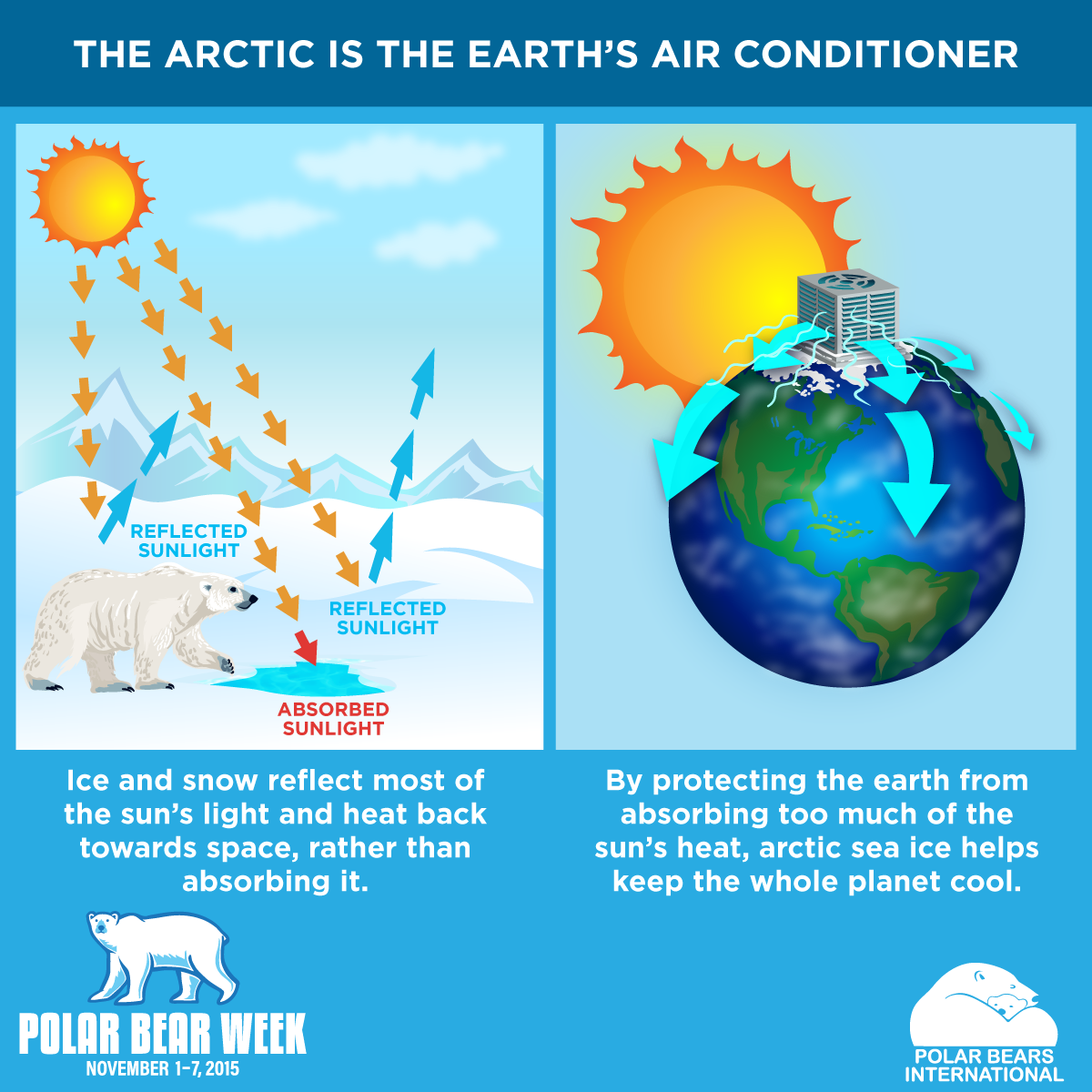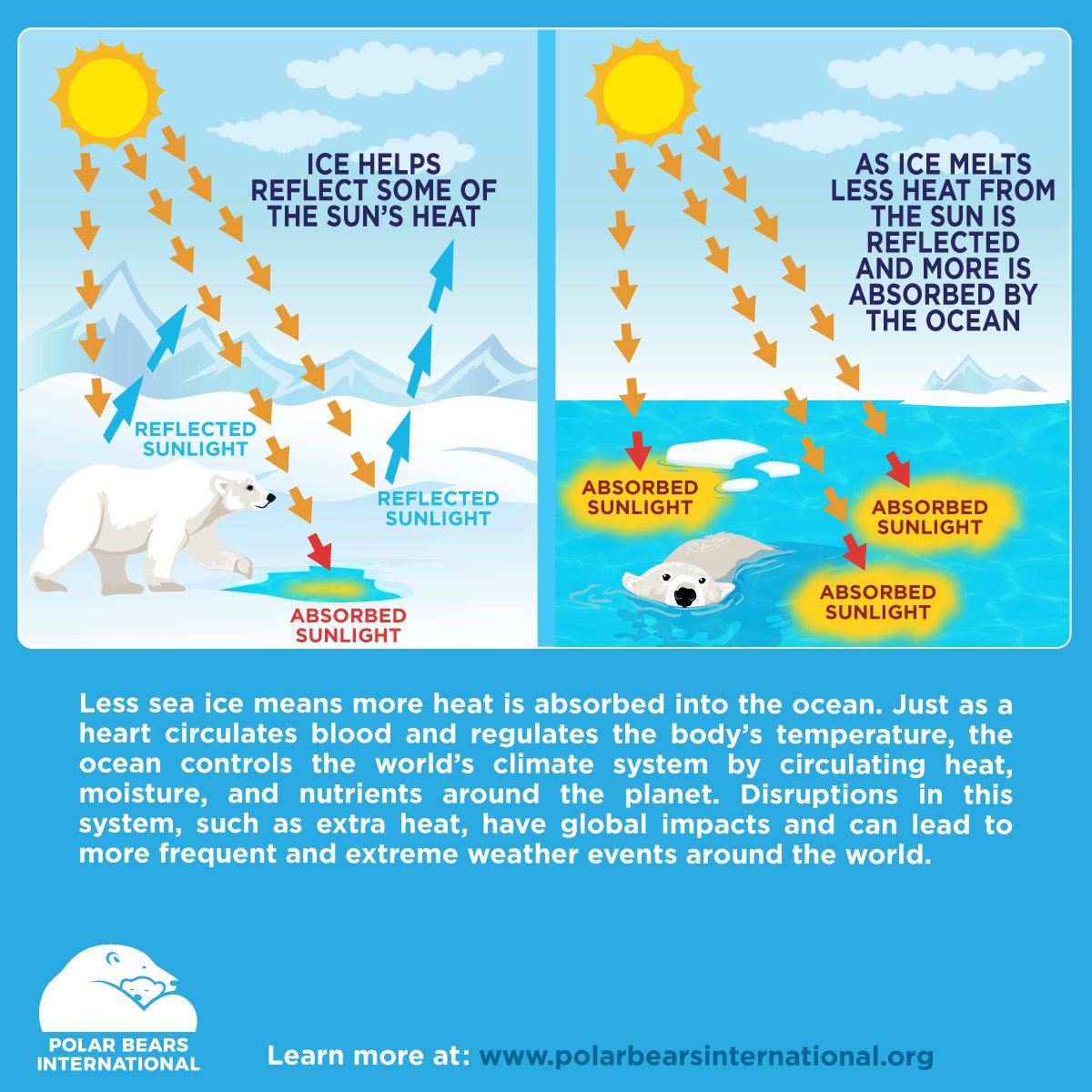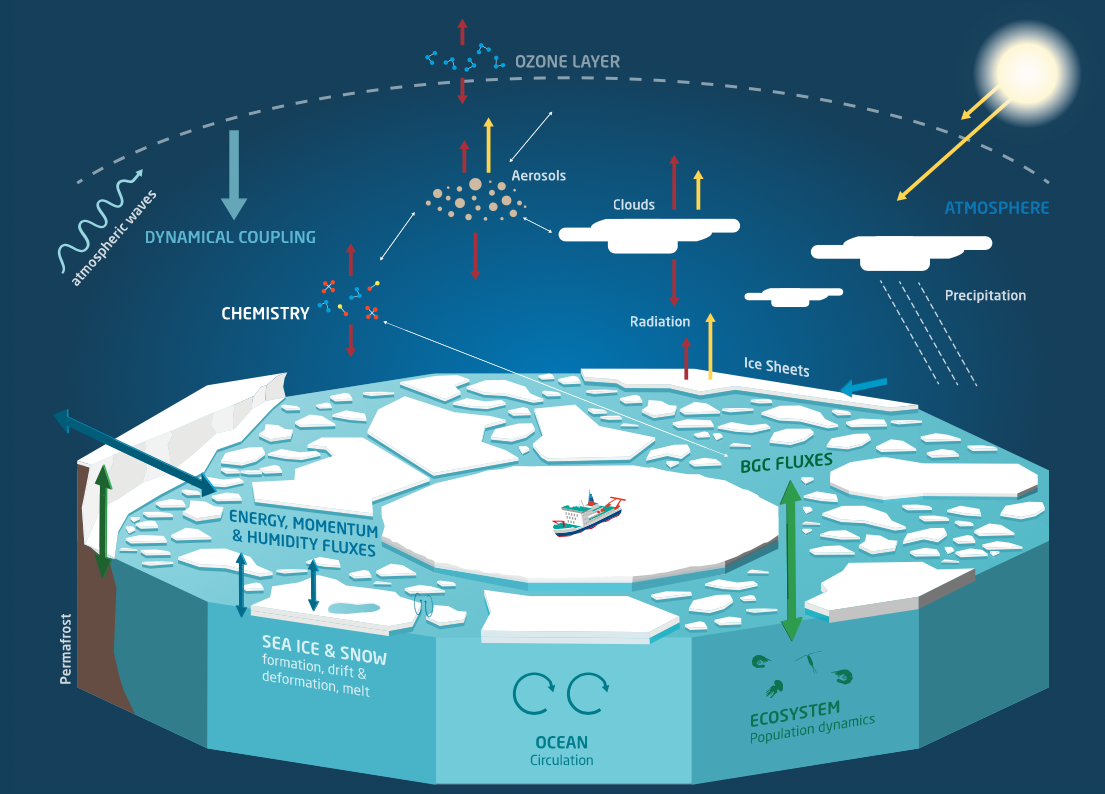Positive Feedbacks to Negative Impacts?
Earth's Energy Budget: Part 3
Gif: Arctic sea ice loss over time; Credit: NASA/Goddard Scientific Visualization Studio
Who doesn't like a little positive feedback from time to time? Being praised for a job well done by a teacher, friend, or boss can feel good. But it turns out that positive feedback isn't always a good thing. In fact, in the Arctic, positive feedbacks can lead to global problems.
If you haven't already, check out Earth's Energy Budget Part 1 and Part 2
A Curious Tropical ParadICE
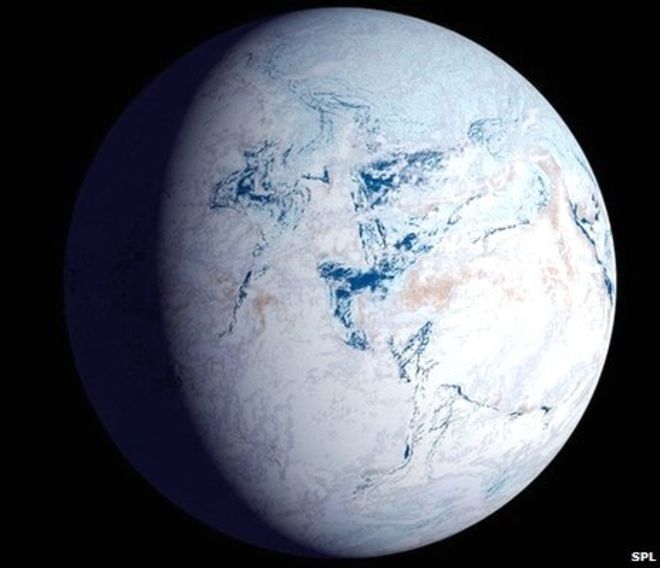
The earth has gone through a series of glacial periods in its lifetime when things were cooler and ice sheets crept down from the poles to cover more of the high latitude regions. However, between the late 1800s and the 1980s, geologists were finding evidence that seemed to show that 650 million or more years ago, glaciers covered landmasses from the poles to the tropics (near the equator)! Could it be that the earth was once covered completely in ice? Some geologists think so (and think it might have happened more than once), and refer to this phenomenon as 'Snowball Earth.' But how could this happen??
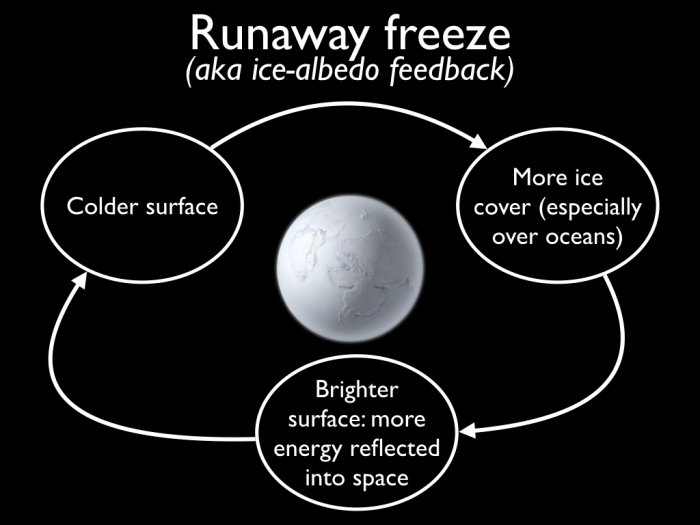
In the 1960s, a Russian climatologist used a simple climate model to show that if ice sheets on Earth became extensive enough, they would reflect enough of the sun's energy (remember that ice has a fairly high albedo) to cause even further cooling on Earth, which would cause more ice sheets to form, which would lead to more cooling....This is called a positive feedback loop - specifically, this phenomenon is called the ice-albedo feedback. Figure credits: SPL
Although there is debate in the scientific community about whether or not Earth was actually once a Snowball (some say it may have been more of a 'Slushball'), there is no dispute that the ice-albedo feedback happens and plays an important role in our planet's climate.
Learn more about Snowball Earth and what might have initiated it in the first place
The Arctic is Earth's Air Conditioner
Just because something is a 'positive' feedback doesn't mean it is necessarily a good thing. 'Positive' just refers to the fact that whatever changes are happening in a system continue to reinforce themselves. Just as the Arctic serves as 'Earth's air conditioner' when it is covered in ice and thus reflects more solar energy (heat) than it absorbs, a decline in Arctic sea ice decreases Earth's albedo and can have a significant impact on our global climate.
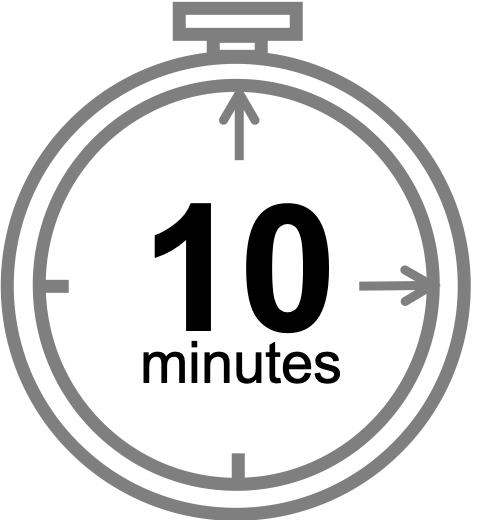 Quick Bite: Melting Ice-Albedo Feedback
Quick Bite: Melting Ice-Albedo Feedback
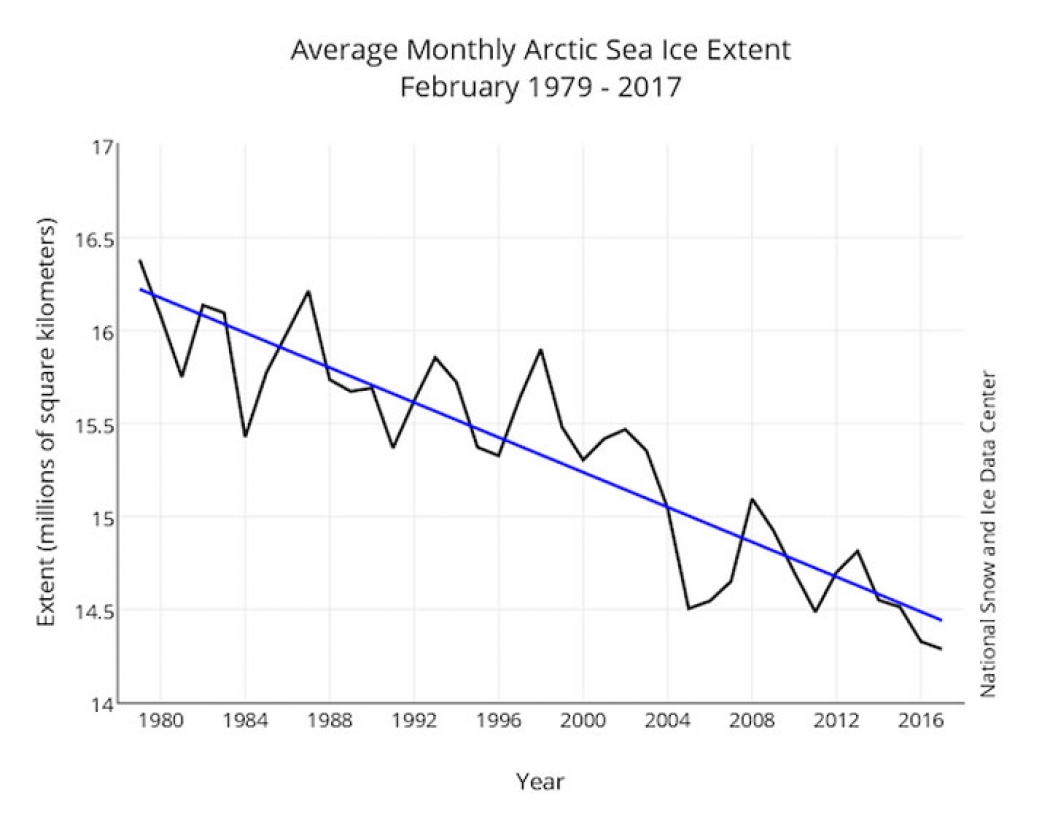
Could the opposite of a Snowball Earth happen? The sea ice extent in the Arctic has been in decline for at least several decades now, which means more dark ocean water is being exposed to the sun's energy more often. Think about what happens to the Arctic albedo as sea ice melts and more and more dark ocean water is exposed. Draw a figure like the one labeled 'Runaway Freeze' above that shows what feedbacks could occur when sea ice melts and what impact this could have on Arctic climate. Do you think these feedbacks in the Arctic could impact Earth's climate globally?
Learn more about positive and negative feedbacks in the Arctic climate system
![]()
![]()
![]()
![]()
![]()
 In the Classroom: Climate is a System
In the Classroom: Climate is a System
Changes in albedo due to changes in sea ice is just one component of the complex Arctic and global climate systems. Atmospheric processes, clouds, ocean currents, and several other things play a role in these systems. MOSAiC expedition participants are members of various research teams that are looking at different components of the Arctic climate system. Figure credit: AWI
Teachers, divide your students up into 5 groups. Each group will represent one of the MOSAiC teams studying a particular aspect of the Arctic climate system: Team Sea Ice, Team Atmosphere, Team Ocean, Team Biogeochemistry, Team Ecosystems. Have each group read about their MOSAiC science focus area (links below). Then, clear a space in your classroom and have the teams stand in a circle. One team will start with a ball of yarn, and they will say one thing about what they are studying and why. If there is a connection between what they are studying and another team, then they will pass the ball of yarn to that team and cut the yarn so that the two teams are linked by the yarn. For example, Team Ecosystems could say that they are studying how melting sea ice could impact microbes that live under the ice. They would then connect themselves to Team Sea Ice via a strand of yarn. Continue around the circle a few more rounds. What do you notice? Are/how are the various teams connected? Do components of the Arctic climate system act in isolation from one another? Why or why not?
Figure credit: AWI
Team Atmosphere Reading Team Sea Ice Reading Team Ocean Reading Team Biogeochemistry Reading Team Ecosystems Reading
 #askmosaic: Is the darkness nice and cracks in the ice
#askmosaic: Is the darkness nice and cracks in the ice
This week we're featuring two #askmosaic questions!
The first question was submitted by Gracie from Middleton Middle School: What is it like to be in total darkness? Do you get deprived?
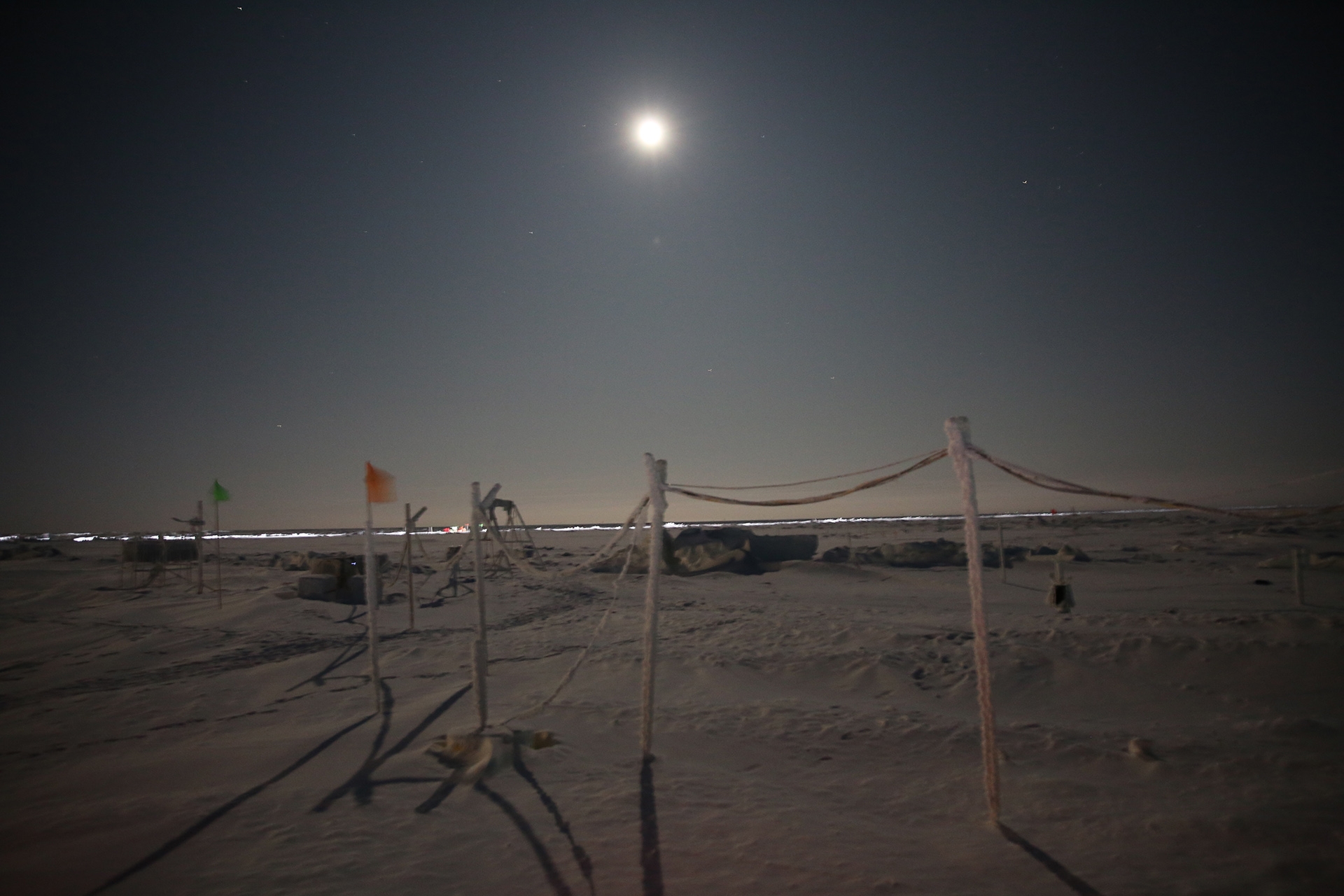
It is strange not to be able to see your environment without the help of artificial light. The ship’s spotlights, portable ones or our headlamps are necessary to work outside. Additionally we have technical devices like the ship’s radar or laser scans and satellite images helping us to get orientated. At one moment the moon did rise above the horizon again – even moonlight is welcome to give light and with the reflecting snow and ice it does quite well. But the darkness makes our world kind of narrow. Before we started the MOSAiC expedition, I expected that the polar night would affect my sleep demand in the way that I would need to sleep more than usual, but this is not really the case. Instead I sometimes wake up in the middle of the night being ready to start the day.
-Folke Mehrtens, Communications Officer at the Alfred Wegener Institute and for MOSAiC currently aboard the Polarstern
Photo (R): Folke Mehrtens took this photo showing how much a full moon illuminates the ice during 'polar night' in the Arctic
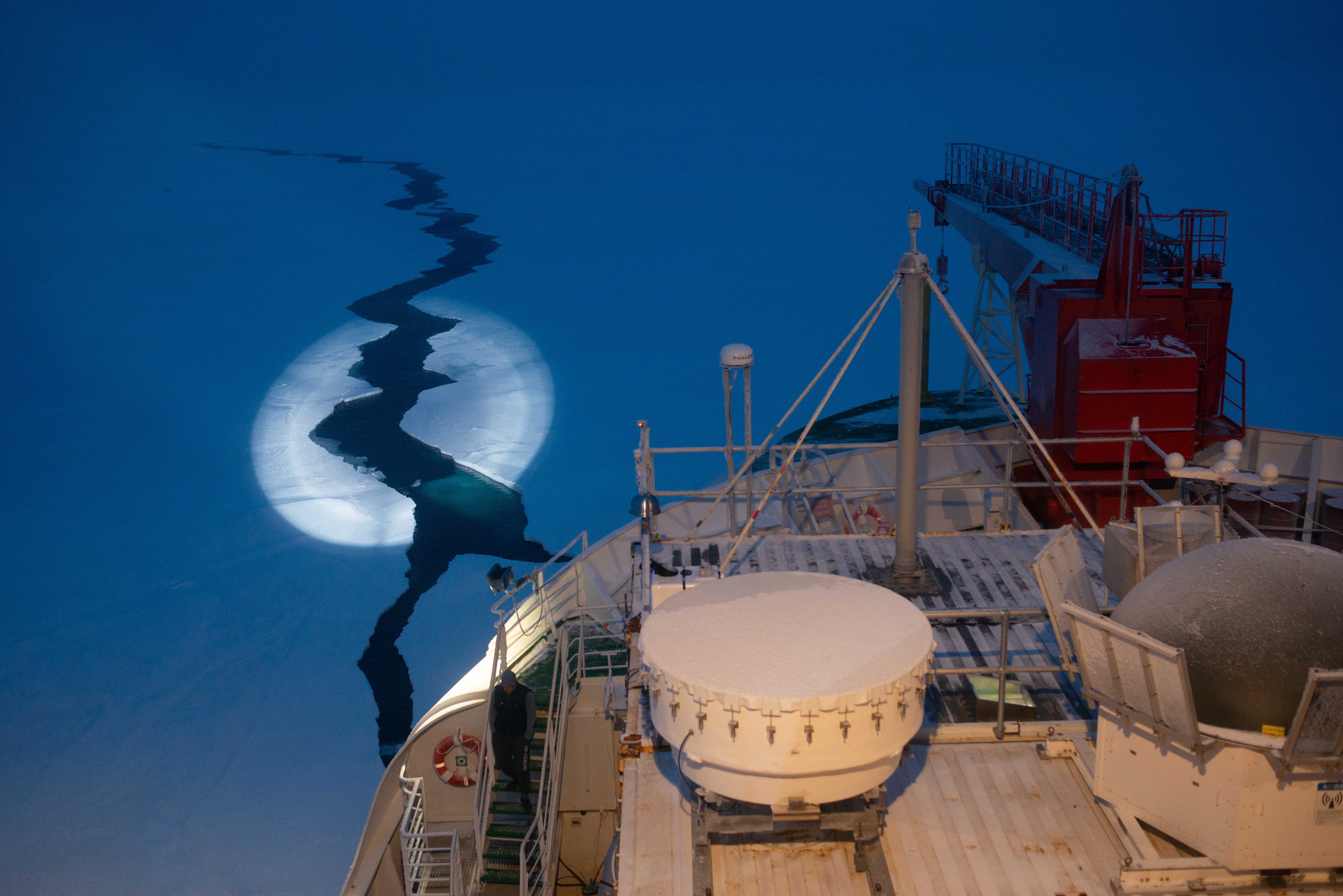
The second question was submitted by Lilly from Seneca Falls Middle School: How long can a crack get in the ice?
Cracks can be anything from a few meters (1 meter = about 3.28 feet) to a few hundred kilometers (1 km = about 0.6 miles). We had a few zigzagging cracks of 100 m (~109 yds) length across our ice floes that closed and healed quickly. However, about 2 km (~1.2 mi) to the east there is a very straight crack that is several kilometers long and continuously opens and closes, and the ice shifts along it.
-Christian Haas, Sea Ice Geophysicist from the Alfred Wegener Institute and Chief Scientist of MOSAiC Leg II
Photo (L): A long crack in the ice in front of the Polarstern. Photo credit: Esther Horvath/AWI
Submit your #askmosaic questions!
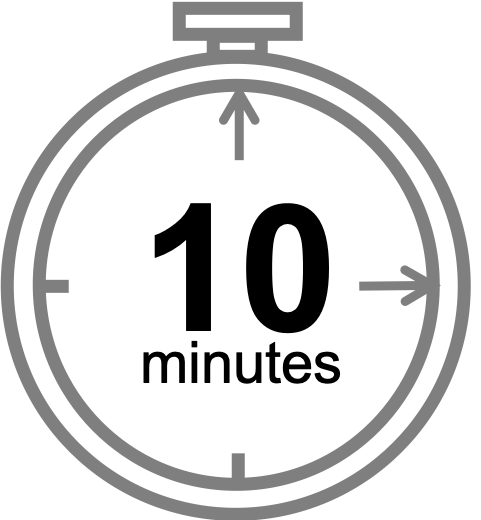 MOSAiC Weekly Tracking
MOSAiC Weekly Tracking
Plot the Polarstern
Each week we will provide you with the latitude and longitude coordinates of the Polarstern so that your students can track its journey across the Arctic in your classroom.
Download the map to plot coordinates
Download a larger map of the Arctic for a bigger picture view of the expedition area
Location of the Polarstern
| Date | Latitude | Longitude |
| September 16, 2019 | 69.68 N | 18.99 E |
| September 23, 2019 | 72.31 N | 26.93 E |
| September 30, 2019 | 85.12 N | 138.05 E |
| October 4, 2019** | 85.08 N | 134.43 E |
| October 7, 2019 | 85.10 N | 133.82 E |
| October 14, 2019 | 84.85 N | 135.03 E |
| October 21, 2019 | 84.97 N | 132.73 E |
| October 28, 2019 | 85.47 N | 127.07 E |
| November 4, 2019 | 85.88 N | 121.70 E |
| November 11, 2019 | 85.82 N | 116.00 E |
| November 18, 2019 | 86.05 N | 122.43 E |
| November 25, 2019 | 85.85 N | 121.35 E |
| December 2, 2019 | 85.97 N | 112.95 E |
| December 9, 2019 | 86.25 N | 121.40 E |
| December 16, 2019 | 86.62 N | 118.12 E |
| December 23, 2019 | 86.63 N | 113.20 E |
| December 30, 2019 | 86.58 N | 117.13 E |
| January 6, 2020 | 87.10 N | 115.10 E |
| January 13, 2020 | 87.35 N | 106.63 E |
| January 20, 2020 | 87.42 N | 97.77 E |
| January 27, 2020 | 87.43 N | 95.82 E |
| February 3, 2020 | 87.42 N | 93.65 E |
| February 10, 2020 | 87.78 N | 91.52 E |
**Day when MOSAiC reached the ice floe that the Polarstern will become frozen in and drift with for the next year.
Log MOSAiC Data
Keep track of Arctic conditions over the course of the expedition:
Download Data Logbook for Sept. 2019 - Dec. 2019
Download Data Logbook for Dec. 2019 - Mar. 2020
| Date | Length of day (hrs) | Air temperature (deg C) at location of Polarstern | Arctic Sea Ice Extent (million km2) |
| September 16, 2019 | 13.25 | High: 10 Low: 4.4 | 3.9 |
| September 23, 2019 | 12.35 | High: 6 Low: -1 | 4.1 |
| September 30, 2019 | 9.1 | -4.7 | 4.4 |
| October 4, 2019** | 6.27 | -13.0 | 4.5 |
| October 7, 2019 | 3.05 | -8.2 | 4.6 |
| October 14, 2019 | 0 | -14.7 | 4.8 |
| October 21, 2019 | 0 | -12.8 | 5.4 |
| October 28, 2019 | 0 | -18.3 | 6.8 |
| November 4, 2019 | 0 | -18.9 | 8.0 |
| November 11, 2019 | 0 | -25.5 | 8.7 |
| November 18, 2019 | 0 | -10.7 | 9.3 |
| November 25, 2019 | 0 | -18.4 | 10.0 |
| December 2, 2019 | 0 | -26.6 | 10.4 |
| December 9, 2019 | 0 | -23.1 | 11.2 |
| December 16, 2019 | 0 | -19.2 | 11.8 |
| December 23, 2019 | 0 | -26.9 | 12.2 |
| December 30, 2019 | 0 | -26.4 | 12.6 |
| January 6, 2020 | 0 | -28.0 | 13.0 |
| January 13, 2020 | 0 | -30.7 | 13.1 |
| January 20, 2020 | 0 | -27.1 | 13.6 |
| January 27, 2020 | 0 | -22.5 | 13.8 |
| February 3, 2020 | 0 | -28.8 | 14.1 |
| February 10, 2020 | 0 | -26.2 | 14.5 |
*Note: We expect data to fall within the following ranges: Length of day, 0-24 hours; Temperature, -40 to 14 degrees C; Sea ice extent, 3-15 million km2
**Day when MOSAiC reached the ice floe that the Polarstern will become frozen in and drift with for the next year.
Contribute to the Museum of MOSAiC Art (MoMOA)
Do you like to draw, paint, sculpt, take photos, build models, knit, sew, write poetry, or engage in any other kind of creative endeavor? We want you to send us photos or scans of your MOSAiC-themed artwork! You can use any artistic medium you like and submit as many creations as you wish to the following categories:
- How the Arctic affects you
- Arctic exploration
- People of the Arctic
- MOSAiC science
- Arctic flora and fauna
- Arctic land and seascapes
- Life on an Arctic icebreaker
- Abstract Arctic
- Other
We'll be showcasing your artwork in the new virtual Museum of MOSAiC Art (MoMOA). Submit photos or scans of your artwork using the submission form below (open to all ages)!
Submit your artwork
Check out the Museum of MOSAiC Art
Questions? Email us with the subject line "MOSAiC Art": mosaic@colorado.edu
Opportunities for Students and Educators
MOSAiC + Reach the World
Exciting news! The MOSAiC education & outreach team has partnered with Reach the World to connect more classrooms to the MOSAiC expedition. Over the coming months, Reach the World will share MOSAiC team members' incredible stories about the expedition, its research, and the everyday challenges of life in the Arctic. MOSAiC team members will also participate in video calls with classrooms to talk more about their experiences directly with students.
Follow the MOSAiC expedition with Reach the World
Arctic Plant Phenology Learning through Engaged Science (APPLES) Workshop for Teachers
Teachers can apply to spend 3 days (June 29-July 1) at Fort Lewis College in Durango, Colorado engaging and collaborating with leading polar research scientists and science educators to learn about the seasonal dynamics of plants and animals in the Arctic. Workshop participants will engage in inquiry-based activities that support the three dimensions of the Next Generation Science Standards (NGSS). Participating teachers will receive a $300 stipend -- the workshop is limited to 10 participants, so register early! Deadline to apply is February 24th.
Register for the APPLES Workshop for Teachers
Learn more about the APPLES project
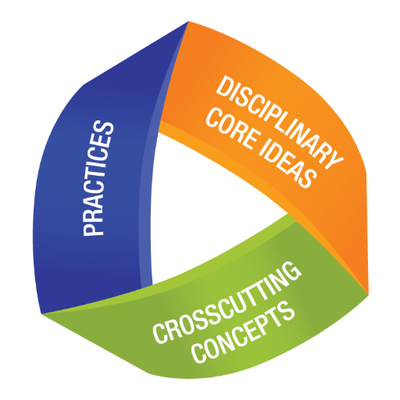 MOSAiC Monday and the NGSS
MOSAiC Monday and the NGSS
What do those funny symbols below some engagements mean?
Good news for educators in the U.S. teaching with the Next Generation Science Standards (NGSS) or similar! We will now be tagging MOSAiC Monday engagements with the NGSS Disciplinary Core Idea subject(s), Science and Engineering Practice(s), and Crosscutting Concept(s) that they most closely connect to. Look for these symbols listed below each engagement:
Disciplinary Core Idea Subjects
Science and Engineering Practices (adopted from the San Diego County Office of Education Science Resource Center)
Crosscutting Concepts (adopted from the San Diego County Office of Education Science Resource Center)
Is there something you'd like to see in MOSAiC Monday? Let us know!
Send us your feedback
New to MOSAiC Monday? Check out past editions!
Browse more expedition-related educational resources, videos, and blogs
Email us! mosaic@colorado.edu

